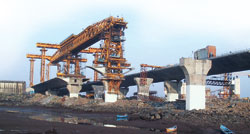Mumbai’s Congestion Will Be Eased by A Concrete Masterpiece
 |
| Gridlock Buster. Sea link viaduct will bypass congestion that snarls roads down the tapering island that forms Mumbai. (Photo left courtesy of Hindustan Construction Co.) |
The link will run north-south across the bays mouth on the citys west side. Its twin decks each will carry four lanes of traffic to the citys commercial southern tip, avoiding gridlocked highways down the narrowing island that forms Mumbai. The project is the first of three sea viaducts planned to serve lower Mumbai.  Click here to view map
Click here to view map
 |
| (Rendering courtesy of a S. Srinivasan, Dar Consultants (U.K.) Ltd. ) |
To placate local objectors to the Sea Link, the Maharashtra State Road Development Corp. Ltd. agreed to divert the southern end of the viaduct some 200 meters further away from the shore. And it added a second 150-m span cable-stayed bridge to ease access for boats moored on the bays south side.
To reschedule work, the owner had the links main 500-m span cable-stayed bridge redesigned to allow its twin decks to be built independently of each other. These changes helped push back the completion date officially to September 2007.
But the main contractor, Hindustan Construction Co. Ltd., Mumbai, believes the following spring is a more likely end date, says project manager P. Jayaram. The owner estimates the change cost about $11 million, not counting inflation.
 |
| Strong Base. With over half the piling now in place, the bridges main pylons are starting to rise. (Photo by Peter Reina for ENR) |
U.S.-based Jacobs Sverdrup, Tullahoma, Tenn., originally designed the viaduct with twin decks, which would share pylons on the links only cable-stayed bridge. But after objectors forced a rethink, MSRDC recruited new designers for the modifications and to manage construction. Jacobs, hired in late 1998, was replaced in early 2003 by Dar al-Handasah Shair and Partners, London.
Because of budget constraints, MSRDC decided to build one of the twin decks well ahead of the other, allowing the earliest possible start of toll revenue, explains Shara M. Sabins. MSRDCs chief engineer. Dar al-Handasah therefore made the cable-stayed bridge decks independently supported with their own pylons. Later funding allowed both decks to open a few months apart, says Jayaram.
 |
| Jayaram |
With its $90-million contract starting in October 2000, HCC had more to worry about than design revisions. Because MSRDC could not gain control of the site, HCC effectively lost a years work, says Jayaram.
With over half the piling now in place, the main bridges pylons are beginning to rise from 6-m-deep pile caps completed last year. Above, HCC is assembling and stressing whole spans of match-cast segmental decks segments on nine-to-ten day cycles, says Jayaram.
HCC has been using four jack-up barges for heavy foundation work. The methods may change if the contractor and designer agree on proposed pile cap design changes that include more precast and composite construction. HCC has four self-propelled barges delivering concrete for foundations and piers.
 |
| Holding Up. Two Indian-built, 1,200-tonne gantries hold segments while they are stressed into place. (Photo courtesy of Hindustan Construction Co.) |
The decks are 18-m-wide, 3.1-m-deep concrete boxes cast at Bandra, on the north side. For durability, the viaducts 40,000 tonnes of rebar is epoxy coated and the concrete contains micro silica and fly ash, says Jayaram. "Permeability is nearly zero," he adds.
HCC is using two Indian-built, 1,200-tonne gantries to hold the 15 segments of entire spans while they are stressed into place. The first gantry is due to complete 18 spans for the main cable-stayed bridge early next year. The second gantry follows by three months.
VSL Singapore Pte. Ltd. designed the gantries and is handling deck prestressing for HCC and its partner China Harbour Engineering Co., Beijing. HCC needed the Chinese contractors bridge track record to qualify for the contract, says Jayaram. China Harbour is fielding a small management team, he says.
The Chinese presence will grow late next year, when the cables start arriving from China, says Jayarm. Under a subcontract, Shanghai Pujiang Cable Engineering Co. Ltd. will supply and install the parallel wire stays for HCC.
By then, MSRDC hopes to be close to starting its two other Mumbai sea crossings. The Western Freeway will extend the Sea Link 13.7 km south to Nariman point. The build-operate-transfer project will include two cable-stayed bridges and be linked to shore with 4.2 km of side connectors along the route.
MSRDC has invited expressions of interest for another BOT contract for the $880-million, 22-km road and rail viaduct from Sewri, Mumbai, eastward over the harbor to Nhava. It has all approvals, says MSRDCs vice president for development, D.B. Deshpande.
